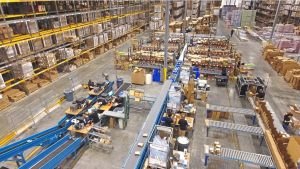California Fulfillment Center is more than just a warehouse. It is the hidden engine that keeps modern commerce alive. Behind every online order is a system that ensures products reach customers quickly and efficiently. These spaces have evolved into technological powerhouses that shape the way goods move in the digital economy.

At its core, a fulfillment center is about precision and timing. Orders are processed, picked, packed, and shipped with incredible speed. The goal is to minimize delays while maintaining accuracy in every step. A single mistake can disrupt the customer experience and damage trust.
What makes fulfillment centers fascinating is their scale. They are not small storage units but sprawling hubs of activity. Thousands of products pass through them daily, each requiring coordination across teams and technology. The choreography of logistics here is as complex as any large performance.
Automation plays a crucial role in their efficiency. Conveyor belts, robotics, and sorting systems reduce the need for manual labor. Machines handle repetitive tasks while people focus on specialized work requiring judgment. This balance between automation and human input defines the modern fulfillment model.
Yet the human element remains vital. Workers ensure that fragile items are packaged securely and that orders are verified. They also handle exceptions when technology cannot solve an issue. Fulfillment centers are proof that even in automated systems, people provide irreplaceable oversight.
The rise of e-commerce has made fulfillment centers indispensable. As consumers expect faster delivery, these centers adapt to meet demand. Same-day and next-day shipping are no longer luxuries but expectations. The ability of a fulfillment center to scale with this demand determines its success.
Location also plays a critical role in their effectiveness. Centers are strategically placed near population hubs to minimize transit times. Their placement reduces costs and improves customer satisfaction. This geographic strategy makes them key players in global supply chains.
Technology within fulfillment centers continues to advance rapidly. Artificial intelligence predicts order volumes and allocates resources accordingly. Data analytics optimize space usage and workforce efficiency. Every decision is driven by the pursuit of reducing cost while increasing speed.
Sustainability is another emerging priority. Energy-efficient systems, recyclable packaging, and eco-friendly processes are gaining attention. Fulfillment centers must balance rapid operations with environmental responsibility. The future of logistics will depend on how well these centers integrate green practices.
For small businesses, fulfillment centers act as gateways to broader markets. They provide storage, shipping, and customer service that would otherwise be impossible. By outsourcing these functions, businesses can scale faster without massive investments. This levels the playing field between startups and established players.
Customers rarely think about the journey their package takes. But inside fulfillment centers, every order is treated as a priority. From scanning barcodes to sealing packages, every step is tracked. Transparency and traceability are built into the system to ensure accountability.
The workforce inside fulfillment centers often faces challenges. Speed targets, repetitive tasks, and physical demands can be intense. Companies are experimenting with ergonomic designs and wellness programs to reduce strain. Balancing productivity with worker well-being is an ongoing challenge.
The growth of online marketplaces has also diversified fulfillment strategies. Some centers specialize in large goods, while others focus on smaller items. Temperature-controlled zones allow storage of perishable goods. This specialization ensures that diverse customer needs can be met.
Fulfillment centers are also shaping consumer expectations. The promise of fast, reliable delivery has changed buying habits. Customers are more likely to choose sellers who can guarantee quick shipping. Thus, logistics has become a competitive advantage rather than a hidden process.
Returns management is another important function. Fulfillment centers don’t just send packages out; they also handle items coming back. Efficient return processes build customer trust and encourage repeat business. Reverse logistics is now seen as equally important as outbound operations.
Globalization adds another layer of complexity. Fulfillment centers must comply with different customs, regulations, and shipping standards. Cross-border logistics requires coordination that goes beyond local efficiency. This global reach transforms fulfillment centers into nodes of international trade.
The digital nature of fulfillment also opens opportunities for personalization. Data from past orders allows centers to include tailored recommendations or packaging. Personalized touches enhance the customer experience and strengthen loyalty. Even in a highly automated system, such details matter.
The rise of subscription services has also impacted fulfillment centers. Regular, recurring shipments require precise scheduling and inventory control. Consistency becomes the key to customer retention in these models. Fulfillment centers adapt by creating systems for predictable and repeatable deliveries.
Emerging technologies like drones and autonomous vehicles are poised to revolutionize the industry. Experimental models already show how last-mile delivery can be accelerated. If these systems scale, fulfillment centers will integrate them into daily operations. The future promises faster and more cost-efficient delivery options.
Beyond commerce, fulfillment centers are also influencing local economies. They create jobs, stimulate infrastructure growth, and attract supporting industries. Their presence can reshape communities by transforming land use and employment trends. However, they also raise concerns about automation replacing human labor.
Security and accuracy remain constant priorities. Every order involves sensitive customer data that must be protected. Sophisticated tracking systems guard against theft, fraud, and errors. Trust in fulfillment centers depends on their ability to safeguard both goods and information.
In times of crisis, such as global disruptions, fulfillment centers reveal their resilience. They adapt supply chains, reroute shipments, and maintain operations under pressure. Their ability to pivot quickly ensures continuity when traditional systems falter. They are silent yet crucial pillars of stability in uncertain times.
Looking forward, the role of fulfillment centers will only expand. As online commerce continues to grow, they will become even more central to daily life. Innovation, sustainability, and adaptability will define the leaders in this field. The evolution of these centers mirrors the evolution of global consumer behavior.
Ultimately, fulfillment centers represent more than logistics. They embody the intersection of technology, efficiency, and human need. They ensure that promises made at the point of purchase are kept at the doorstep. In doing so, they transform commerce from a transaction into a reliable and trusted relationship.
Their story is still being written. With each advancement in technology and each shift in consumer demand, fulfillment centers adapt. They remain the quiet engines driving the modern economy forward. And as long as goods must move, their importance will only continue to grow.
